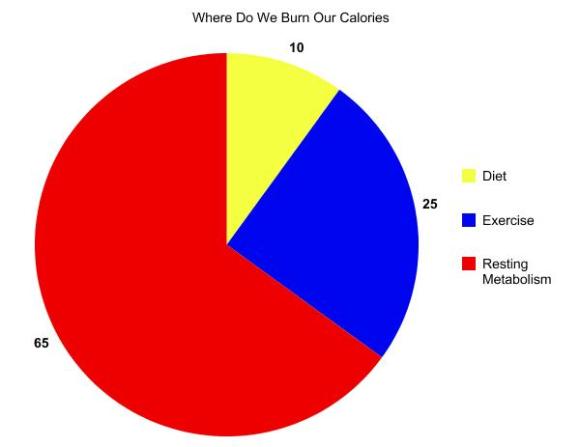Lets face it. Losing weight is not easy, if it was we would all look like Ryan Reynolds and Mila Kunis. But unfortunately we can’t all be like them, You work hard in the gym all year to look/feel exactly the same, and you are stuck wondering what you are doing wrong.
Your body works in mysterious ways when it comes to losing weight, for example: Stress and/or pain causes Cortisol levels in the body to rise, and Cortisol is your fight or flight response to stress which causes your body to go into panic mode and hold onto any fat that is in your body.
Getting back on topic: Lets look at how your body burns calories in a typical day.
3 numbers come to mind:
10%
20-30%
60-70%
What do these numbers have in common? (besides that they equal out 100%). They Correlate with how your body uses calories.
10%: The amount of calories you can burn total from just diet alone (any more and your metabolic rate will drop).
20-30%: The amount of calories you can burn during your daily workout.
60-70%: The amount of calories you burn during your Resting Metabolism (the 23ish hours you aren’t at the gym).
So for lack of a better Picture, this is about how it should look: (I used 25 and 65 for the two because I am lazy)
Pretty Simple Right?
Ok so by this logic, which area of the Chart should we concentrate most of our efforts?
Our Resting Metabolism
That is the time we don’t spend at the gym.
Now onto the better question: How do we give our resting metabolism the greatest boost, so we can burn the most calories and lose the most weight?
I will break down the 5 basic exercise routines in the order of most effective to least effective:
1) Metabolic Resistance Training
2) High Intensity Anaerobic Interval Training
3) High Intensity Aerobic Interval Training
4) High Intensity Steady State Cardio
4) Low Intensity Steady State Cardio
Okay so before you give me that “confused dog look” Let me explain.
(Photo of Eric Cressey’s Dog Tank)
Metabolic Resistance Training: This is your typical Weight Training. Lifting heavy weights, getting a real sweat on, and just being an overall Badass.
High Intensity Anaerobic Interval Training: Anaerobic means without oxygen, so any type of interval training where your muscles do not need oxygen to function. That includes short quick bursts of “work” lasting less than 30(ish) seconds. Examples: 20m sprints, 15 second sprints on the (insert cardio machine), 10 explosive box jumps, etc. Anything that is quick, explosive and leaves you extremely tired very quickly.
High Intensity Aerobic Interval Training: Aerobic means with oxygen. So this is your typical type of interval training with exercises lasting in the range of 1-2 minutes without rest. Example: Interval of 1 minute running and 1 minute walking on the tredmil, things of that sort.
High Intensity Steady State Cardio: This is what the “above average” person does, we call this person the “Cardio Junkie”. Someone who goes on the elliptical/tredmill/stepper and goes till they can’t go anymore (and are usually dripping puddles afterwards). It basically means working out at a constant pace with your heart rate at or above 85% of your maximum heart rate. Example: the average 40 year old’s max heart rate is 180 BPM (beats per minute), so working at 85% of that would be 153 BPM.
Low Intensity Steady State Cardio: This is the typical “Fat Burning Zone” that is listed on all cardio machines. This person is easy to identify as well, as they are usually just there for the ride. They will be on the machine for an hour easily and barely break a sweat. This type of exercises consists of cardio at the 65-85% of your maximum heart rate.
So Moment of Truth here: Why does Metabolic Resistance Training have the greatest effect on your Resting Metabolism?
The answer is Muscle Recovery Rate.
Metabolic Resistance Training has the highest Muscle Recovery of any other type of exercise. When your muscles are recovering they are consuming calories to recover and therefore increasing your base metabolic rate (the rate at which you burn calories at rest).
The average Muscle Recovery for Cardio is between 60 and 90 minutes. So you are burning extra calories in “recovery mode” for about an hour, then your body is fully recovered.
The average Muscle Recovery for Metabolic Resistance Training is up to 24 Hours (yes you read that correctly).
So say for example you burn an average of 500 calories an hour during your workout (either cardio or resistance training). Your recovery rate for cardio may burn an extra 50-70 calories (rough estimate), while resistance training can yield you an extra 300 (again rough estimate) calorie burn, therefore having the biggest impact on your resting metabolism, which will boost your base metabolic rate, and therefore give you the best chance at losing weight.
So yes you are working out (the first correct step), but the pre-conception that only doing cardio will help you lose weight and if you so much as look at a dumbell you will turn into the Hulk, is absolutely not true. Metabolic Resistance Training will yield you the best results to shedding that unwanted body fat, so get off the Stairmaster, walk to the other side of the gym and lift some heavy weights and really earn those results that you so desperately want.

